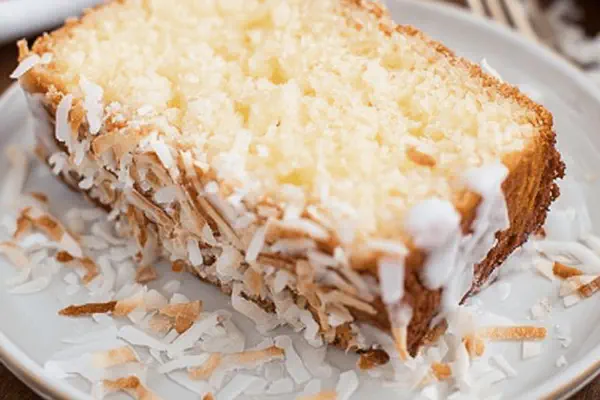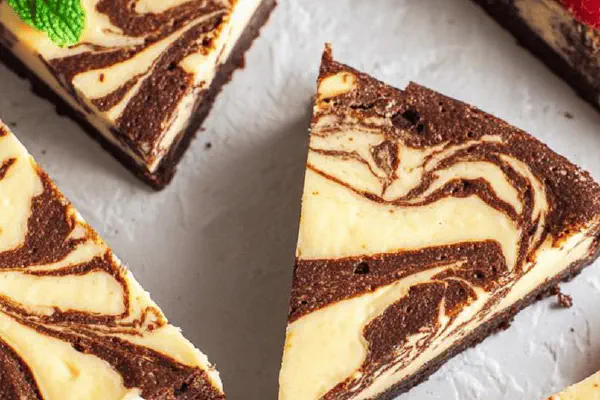Coconut Pound Cake

By Emma
Certified Culinary Professional
Ingredients
- 2 sticks unsalted butter softened
- 4 oz cream cheese softened
- 1 1/2 cups granulated sugar
- 1 teaspoon vanilla bean paste instead of almond extract
- 1 teaspoon coconut extract
- 1 tablespoon flaked coconut for batter
- 3 cups all-purpose flour sifted
- 1/2 teaspoon fine sea salt
- 4 large eggs room temperature
- 3/4 cup flaked coconut for folding in
- For glaze
- 2 cups powdered sugar sifted
- 3 tablespoons unsalted butter softened
- 1 teaspoon coconut extract
- 2-3 tablespoons whole milk or coconut milk
About the ingredients
Method
Cake Prep
- Start with greasing two 9-inch loaf pans generously with butter; toss flour in and shake till coated evenly. No dry patches. This keeps cake from sticking like in my first try when overlooked.
- Use a stand mixer or heavy-duty bowl and paddle. Beat butter, cream cheese, sugar till pale, fluffy. Look for that thick spreading consistency, not grainy sugar bits.
- Add vanilla bean paste and coconut extract now. Almond extract? Too sharp sometimes; vanilla paste gives subtle depth, better with coconut. Stir in 1 tablespoon flaked coconut by hand, sparing the mixer, preserves chew.
- Sift flour with salt together to avoid clumps. Egg by egg mix into butter mix — add flour in thirds alternating with eggs to keep batter smooth. Scrape bowl often. Batter looks soft but thick.
- Fold in remaining 3/4 cup coconut gently. Don't overdo or cake turns dense. Just enough to spot texture.
- Split batter evenly into pans. Smooth tops with wet spatula; helps even rise.
Baking
- Oven set at 325°F (160°C). Baking low ensures moist crumb and no burnt edges. Start checking at 70 minutes. Toothpick inserted near center should come out with moist crumbs—not sticky batter.
- Listen for silence from oven when done; if crackling stops, most likely ready. Loaves shrink slightly from sides — good sign cake set inside.
- Let rest 8-10 minutes to firm. Run knife around edges before removing to avoid breakage.
Glaze
- Mix powdered sugar with softened butter using fork or pastry cutter until crumbly. Add coconut extract and just enough milk to make drizzle consistency. Too thin — runs off, too thick — clumps, adjust carefully.
- Pour glaze over warm cakes still on racks so it drips over edges naturally. Should set shiny but not hard.
- Sprinkle extra coconut flakes immediately for texture, contrast.
Notes
- Swap butter with coconut oil in glaze for dairy-free option; adds tropical twist.
- If cake feels dry next day, brush with simple syrup infused with coconut extract before glazing.
- Storing wrapped airtight overnight improves flavor melding.
- Watch baking time precisely; each oven varies. Better early check than dried cake.
- Experience counts here — smell for nutty coconut aroma, light golden crust, texture that springs back under finger.
- Avoid overmixing flour or folding in coconut too aggressively; both weigh batter down.
- Stop mixer when ingredients just combined for tender crumb.
- Try chilling batter briefly for cleaner slices.
- Use fresh flaked coconut for best texture; dried packs hydrate with little coconut milk stir.
- Don't skip butter-flour step on pans — bitter stuck edges ruin loaf.
- Replacing almond extract keeps it safe for nut allergies without losing dimension.
- Coat racks with foil underneath to catch glaze drips for easy cleanup.
Cooking tips
Chef's notes
- 💡 Butter soft, really soft, room temperature not just slightly. Cream with cream cheese and sugar till thick, pale, no grainy sugar lumps. Key texture sets crumb structurally. Stop mixer early once combined — keeps crumb tender, no toughness.
- 💡 Fold coconut in by hand — mixer crushes flakes, kills chew feel. Timing matters; add just before flour so it disperses evenly but stays distinct. Use fresh or drained canned flakes only. Dry flakes get chewy dry without rehydrating or adding coconut milk.
- 💡 Oven set low 325°F. Bake slow, no rushing. Moist crumb comes from low heat and long time. Check at 70 minutes with toothpick near center. Should come out with moist crumbs but no sticky batter. Wait past full dryness — crumbs signal perfect bake zone.
- 💡 Grease pans thoroughly then dust flour evenly. Skip either and edges stick, burn or crust breaks. Tap excess flour off. Loaf shrink from edges signals set cake interior. If no shrink, might be underbaked or batter too wet.
- 💡 Glaze thick but pourable; add milk carefully. Too thin runs off, too thick clumps weird. Mix powdered sugar and softened butter first. Add coconut extract last. Glaze warm cake for shiny finish, sprinkle flakes while still sticky for contrast.
Common questions
Can I swap butter with coconut oil?
Yes, in glaze works well; adds tropical note. Batter swap changes texture, can be softer but watch bake time. Coconut oil solidifies differently, affects crumb.
What if cake feels dry next day?
Brush with simple syrup infused coconut extract before glazing. Adds moisture, prevents stale. Alternative: cover airtight with slice of bread inside container to keep moisture.
How to test doneness without overbaking?
Toothpick test crucial; moist crumbs good, no wet batter. Edges pulling from pan sides signal done. Oven silence cues crackling stops. Rely on feel, smell caramelizing coconut aroma also hints readiness.
Best way to store leftover cake?
Wrap airtight overnight for flavors to meld. Refrigerate in freezer bag for longer storage but can dry. Room temp a day or two okay if covered; glaze seals moisture somewhat.



